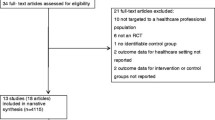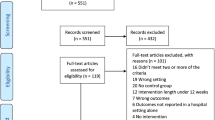Abstract
Purpose of review
This study aims to summarize the recent peer-reviewed literature on workplace interventions for prevention of type 2 diabetes mellitus (T2DM), including studies that translate the Diabetes Prevention Program (DPP) curriculum to workplace settings (n = 10) and those that use different intervention approaches to achieve the specific objective of T2DM prevention among employees (n = 3).
Recent findings
Weight reduction was achieved through workplace interventions to prevent T2DM, though such interventions varied substantially in their effectiveness. The greatest weight loss was reported among intensive lifestyle interventions (i.e., at least 4 months in duration) that implemented the structured DPP curriculum (n = 3). Weight reduction was minimal among less intensive interventions, including those that substantially modified the DPP curriculum (n = 2) and those that used non-DPP intervention approaches to prevent T2DM (n = 3). Most studies (n = 12) reported increased levels of physical activity following the intervention.
Summary
Implementation of the DPP in workplaces may be an effective strategy to prevent T2DM among employees.

Similar content being viewed by others
References
Papers of particular interest, published recently, have been highlighted as: • Of importance •• Of major importance
2014 Diabetes Report Card—diabetesreportcard2014.pdf [Internet]. [cited 2016 May 27]. Available from: http://www.cdc.gov/diabetes/pdfs/library/diabetesreportcard2014.pdf
Ramsey S, Summers KH, Leong SA, Birnbaum HG, Kemner JE, Greenberg P. Productivity and medical costs of diabetes in a large employer population. Diabetes Care. 2002;25:23–9.
NBCH_AB_PREDIABETES_UPDATED 10.16.13.pdf [Internet]. [cited 2016 Aug 9]. Available from: https://www.nbch.org/nbch/files/ccLibraryFiles/Filename/000000003046/NBCH_AB_PREDIABETES_UPDATED%2010.16.13.pdf
Programs | Diabetes Interventions | Workplace Health Strategies by Condition | Workplace Health Promotion | CDC [Internet]. [cited 2016 Sep 19]. Available from: http://www.cdc.gov/workplacehealthpromotion/health-strategies/diabetes/interventions/programs.html
Group DPPR, others. Reduction in the incidence of type 2 diabetes with lifestyle intervention or metformin. N Engl J Med. 2002;346:393.
Ackermann RT, Finch EA, Brizendine E, Zhou H, Marrero DG. Translating the Diabetes Prevention Program into the community. Am J Prev Med. 2008;35:357–63.
Vojta D, Koehler TB, Longjohn M, Lever JA, Caputo NF. A coordinated national model for diabetes prevention. Am J Prev Med. 2013;44:S301–6.
Ali MK, Echouffo-Tcheugui JB, Williamson DF. How effective were lifestyle interventions in real-world settings that were modeled on the Diabetes Prevention Program? Health Aff (Millwood). 2012;31:67–75.
Ma J, Yank V, Xiao L, Lavori PW, Wilson SR, Rosas LG, et al. Translating the Diabetes Prevention Program lifestyle intervention for weight loss into primary care: a randomized trial. JAMA Intern Med. 2013;173:113.
McTigue KM, Conroy MB, Bigi L, Murphy C, McNeil M. Weight loss through living well: translating an effective lifestyle intervention into clinical practice. Diabetes Educ. 2009;35:199–208.
Whittemore R, Melkus G, Wagner J, Dziura J, Northrup V, Grey M. Translating the Diabetes Prevention Program to primary care: a pilot study. Nurs Res. 2009;58:2–12.
Alex ADA 1701 NBS, ria, 1-800-Diabetes V 22311. Stop diabetes @ work for employers [Internet]. Am. Diabetes Assoc. [cited 2016 Aug 9]. Available from: http://www.diabetes.org/in-my-community/awareness-programs/stop-diabetes-at-work/employer-log-in-to-stop-diabetes.html
Prevent Diabetes STAT | General Public [Internet]. Prev. Diabetes STAT. [cited 2016 Aug 9]. Available from: http://www.preventdiabetesstat.org
Employer-Leave-Behind.pdf [Internet]. [cited 2016 Aug 9]. Available from: http://cwpstl.org/wp-content/uploads/2014/10/Employer-Leave-Behind.pdf
AHIP_IssueBrief_NDPP.pdf [Internet]. [cited 2016 Aug 10]. Available from: https://www.ahip.org/wp-content/uploads/2016/03/AHIP_IssueBrief_NDPP.pdf
Schmittdiel JA, Brown SD, Neugebauer R, Adams SR, Adams AS, Wiley D, et al. Health-plan and employer-based wellness programs to reduce diabetes risk: the Kaiser Permanente Northern California NEXT-D study. Prev. Chronic. Dis. [Internet]. 2013 [cited 2016 Aug 9];10. Available from: http://www.cdc.gov/pcd/issues/2013/12_0146.htm
Lindström J, Neumann A, Sheppard K, Gilis-Januszewska A, Greaves C, Handke U, et al. Take action to prevent diabetes—the IMAGE toolkit for the prevention of type 2 diabetes in Europe. Horm Metab Res. 2010;42:S37–55.
Richardson E, Zaletel J, Nolte E. National diabetes plans in Europe. 2016 [cited 2016 Aug 26]; Available from: http://www.euro.who.int/__data/assets/pdf_file/0009/307494/National-diabetes-plans-Europe.pdf
Prevention [Internet]. Int. Diabetes Fed. [cited 2016 Sep 19]. Available from: http://www.idf.org/prevention
Whittemore R. A systematic review of the translational research on the Diabetes Prevention Program. Transl Behav Med. 2011;1:480–91.
Goetzel RZ, Ozminkowski RJ. The health and cost benefits of work site health-promotion programs. Annu Rev Public Health. 2008;29:303–23.
Laws RA, St. George AB, Rychetnik L, Bauman AE. Diabetes prevention research. Am J Prev Med. 2012;43:205–14.
Dunkley AJ, Bodicoat DH, Greaves CJ, Russell C, Yates T, Davies MJ, et al. Diabetes prevention in the real world: effectiveness of pragmatic lifestyle interventions for the prevention of type 2 diabetes and of the impact of adherence to guideline recommendations: a systematic review and meta-analysis. Diabetes Care. 2014;37:922–33.
Kruger J, Yore MM, Bauer DR, Kohl HW. Selected barriers and incentives for worksite health promotion services and policies. Am J Health Promot AJHP. 2007;21:439–47.
Person AL, Colby SE, Bulova JA, Eubanks JW. Barriers to participation in a worksite wellness program. Nutr Res Pract. 2010;4:149.
Kaspin LC, Gorman KM, Miller RM. Systematic review of employer-sponsored wellness strategies and their economic and health-related outcomes. Popul Health Manag. 2013;16:14–21.
Linnan L, Bowling M, Childress J, Lindsay G, Blakey C, Pronk S, et al. Results of the 2004 national worksite health promotion survey. Am J Public Health. 2008;98:1503–9.
Baicker K, Cutler D, Song Z. Workplace wellness programs can generate savings. Health Aff (Millwood). 2010;29:304–11.
hsc_manual.pdf [Internet]. [cited 2016 Sep 19]. Available from: http://www.cdc.gov/dhdsp/pubs/docs/hsc_manual.pdf
Venditti EM, Kramer MK. Necessary components for lifestyle modification interventions to reduce diabetes risk. Curr Diab Rep. 2012;12:138–46.
A recommendation to improve employee weight status through worksite health promotion programs targeting nutrition, physical activity, or both. Am. J. Prev. Med. 2009;37:358–9.
Tuomilehto J, Lindström J, Eriksson JG, Valle TT, Hämäläinen H, Ilanne-Parikka P, et al. Prevention of type 2 diabetes mellitus by changes in lifestyle among subjects with impaired glucose tolerance. N Engl J Med. 2001;344:1343–50.
dprp-standards.pdf [Internet]. [cited 2016 Sep 5]. Available from: http://www.cdc.gov/diabetes/prevention/pdf/dprp-standards.pdf
Anderson LM, Quinn TA, Glanz K, Ramirez G, Kahwati LC, Johnson DB, et al. The effectiveness of worksite nutrition and physical activity interventions for controlling employee overweight and obesity. Am J Prev Med. 2009;37:340–57.
Thorndike AN. Workplace interventions to reduce obesity and cardiometabolic risk. Curr Cardiovasc Risk Rep. 2011;5:79–85.
Conn VS, Hafdahl AR, Cooper PS, Brown LM, Lusk SL. Meta-analysis of workplace physical activity interventions. Am J Prev Med. 2009;37:330–9.
Leutzinger J, Pirner M, Landschulz W, Nevins RL, Sullivan S, Silberman C. Metabolic syndrome and worksite health promotion. Am J Health Promot AJHP. 2006;21:1–11.
Aldana SG, Barlow M, Smith R, Yanowitz FG, Adams T, Loveday L, et al. The diabetes prevention program: a worksite experience. AAOHN J Off J Am Assoc Occup Health Nurses. 2005;53:499–505-507.
Aldana S, Barlow M, Smith R, Yanowitz F, Adams T, Loveday L, et al. A worksite diabetes prevention program: two-year impact on employee health. AAOHN J Off J Am Assoc Occup Health Nurses. 2006;54:389–95.
Barham K, West S, Trief P, Morrow C, Wade M, Weinstock RS. Diabetes prevention and control in the workplace: a pilot project for county employees. J Public Health Manag Pract. 2011;17:233–41.
Dallam GM, Foust CP. A comparative approach to using the diabetes prevention program to reduce diabetes risk in a worksite setting. Health Promot Pract. 2013;14:199–204.
DeJoy DM, Padilla HM, Wilson MG, Vandenberg RJ, Davis MA. Worksite translation of the diabetes prevention program formative research and pilot study results from FUEL Your Life. Health Promot Pract. 2012;22:1524839912461014.
Faghri PD, Li R. Effectiveness of financial incentives in a worksite Diabetes Prevention Program. Open Obes J. 2014;6:1–12.
Giese KK, Cook PF. Reducing obesity among employees of a manufacturing plant: translating the Diabetes Prevention Program to the workplace. Workplace Health Saf. 2014;62:136.
• Kramer MK, Molenaar DM, Arena VC, Venditti EM, Meehan RJ, Miller RG, et al. Improving employee health: evaluation of a worksite lifestyle change program to decrease risk factors for diabetes and cardiovascular disease. J Occup Environ Med. 2015;57:284–91. This study shows favorable weight loss outcomes in a workplace Diabetes Prevention Program, which offered participants in-person and DVD options.
Townsend CKM, Miyamoto RES, Antonio M, Zhang G, Paloma D, Basques D, et al. The PILI@Work Program: a translation of the diabetes prevention program to Native Hawaiian-serving worksites in Hawai‘i. Transl Behav Med. 2016;6:190–201.
• Weinhold KR, Miller CK, Marrero DG, Nagaraja HN, Focht BC, Gascon GM. A randomized controlled trial translating the Diabetes Prevention Program to a university worksite, Ohio, 2012–2014. Prev Chronic Dis. 2015;8:12. Available from: http://www.ncbi.nlm.nih.gov/pmc/articles/PMC4674443/. This study shows favorable weight loss outcomes in a 16-week workplace Diabetes Prevention Program.
Zyriax B-C, Letsch B, Stock S, Windler E. DELIGHT (Delay of impaired glucose tolerance by a healthy lifestyle trial)—a feasibility study on implementing a program of sustainable diabetes prevention in German companies. Exp Clin Endocrinol Diabetes. 2013;122:20–6.
Bevis CC, Nogle JM, Forges B, Chen PC, Sievers D, Lucas KR, et al. Diabetes wellness care: a successful employer-endorsed program for employees. J Occup Environ Med. 2014;56:1052–61.
Burton WN, Chen C-Y, Li X, Erickson D, McCluskey M, Schultz A. A worksite occupational health clinic-based diabetes mellitus management program. Popul Health Manag. 2015;18:429–36.
Viitasalo K, Hemiö K, Puttonen S, Hyvärinen H-K, Leiviskä J, Härmä M, et al. Prevention of diabetes and cardiovascular diseases in occupational health care: feasibility and effectiveness. Prim Care Diabetes. 2015;9:96–104.
risk-test-paper-version.pdf [Internet]. [cited 2016 Sep 5]. Available from: http://main.diabetes.org/dorg/PDFs/risk-test-paper-version.pdf
Neamah HH, Kuhlmann AKS, Tabak RG. Effectiveness of program modification strategies of the diabetes prevention program: a systematic review. Diabetes Educ. 2016;15:145721716630386.
Hamman RF, Wing RR, Edelstein SL, Lachin JM, Bray GA, Delahanty L, et al. Effect of weight loss with lifestyle intervention on risk of diabetes. Diabetes Care. 2006;29:2102–7.
Venditti EM, Bray GA, Carrion-Petersen ML, Delahanty LM, Edelstein SL, Hamman RF, et al. First versus repeat treatment with a lifestyle intervention program: attendance and weight loss outcomes. Int J Obes. 2008;32:1537–44.
•• Mudaliar U, Zabetian A, Goodman M, Echouffo-Tcheugui JB, Albright AL, Gregg EW, et al. Cardiometabolic risk factor changes observed in Diabetes Prevention Programs in US Settings: a systematic review and meta-analysis. PLoS Med. 2016;13:e1002095. This is the most recent systematic review and meta-analysis of 44 translational Diabetes Prevention Programs in community and clinical settings.
Goetzel RZ, Henke RM, Tabrizi M, Pelletier KR, Loeppke R, Ballard DW, et al. Do workplace health promotion (wellness) programs work? J Occup Environ Med. 2014;56:927–34.
Henke RM, Goetzel RZ, McHugh J, Isaac F. Recent experience in health promotion at Johnson & Johnson: lower health spending. Strong Return On Investment Health Aff (Millwood). 2011;30:490–9.
Johnson M, Jones R, Freeman C, Woods HB, Gillett M, Goyder E, et al. Can diabetes prevention programmes be translated effectively into real-world settings and still deliver improved outcomes? A synthesis of evidence. Diabet Med. 2013;30:3–15.
Durlak JA, DuPre EP. Implementation matters: a review of research on the influence of implementation on program outcomes and the factors affecting implementation. Am J Community Psychol. 2008;41:327–50.
Acknowledgments
Dr. Hafez acknowledges support from the Robert Wood Johnson Foundation in her role as a Clinical Scholar. Dr. O’Brien acknowledges support from the National Institute of Diabetes and Digestive and Kidney Disease, National Institutes of Health (DK-K23095981). Dr. Ackermann acknowledges support from the National Center for Advancing Translational Sciences (UL1 TR001422). Dr. Kullgren is a VA HSR&D Career Development awardee at the Ann Arbor, VA. Dr. Kullgren also received grants from the Robert Wood Johnson Foundation, from the US Department of Veterans Affairs, and from the Donaghue Foundation.
The views expressed in this article are those of the authors and do not necessarily reflect the position or policy of the Department of Veterans Affairs or the United States government.
Author information
Authors and Affiliations
Corresponding author
Ethics declarations
Conflict of Interest
Dina Hafez, Allison Fedewa, Margaret Moran, Matthew O’Brien, and Ronald Ackermann declare that they have no conflict of interest. Jeffrey T. Kullgren has received consulting fees from SeeChange Health and HealthMine.
Human and Animal Rights and Informed Consent
This article does not contain any studies with human or animal subjects performed by any of the authors.
Additional information
This article is part of the Topical Collection on Economics and Policy in Diabetes
Electronic supplementary material
Below is the link to the electronic supplementary material.
ESM 1
(DOCX 15 kb)
Rights and permissions
About this article
Cite this article
Hafez, D., Fedewa, A., Moran, M. et al. Workplace Interventions to Prevent Type 2 Diabetes Mellitus: a Narrative Review. Curr Diab Rep 17, 9 (2017). https://doi.org/10.1007/s11892-017-0840-0
Published:
DOI: https://doi.org/10.1007/s11892-017-0840-0




